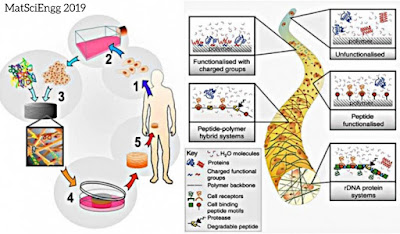5 NEXT BIG THINGS IN MATERIAL SCIENCE & ENGINEERING:
We know how buzzing the word materials science is these days. Sometimes it is amusing to see the scope of
material science and sometimes it may seem to be a bit exaggerated to the layman.
However, we cannot rub it off just like that since its future is just jaw-dropping. Below are the few going to be big things in the game of Science and Engineering.
1. Biomaterials
for Tissue Engineering
2. Ceramics
and glasses
3. Nanotechnology
4.
Functional materials
5. Engineering
alloys (for various applications)
Biomaterials
in tissue engineering:
Advances in tissue building incorporate disclosures from natural
chemistry, cell and sub-atomic science, and materials science to create
three-dimensional structures with explicit properties that empower us to
supplant or fix harmed, missing or inadequately working organic segments
Advanced Ceramics and glasses:
Earthenware is a material that is neither metallic nor
natural. It might be crystalline, polished or both crystalline and lustrous.
Earthenware production is normally hard and artificially non-responsive and can
be framed or densities with warmth. Earthenware production is more than
stoneware and dishes: mud, blocks, tiles, glass, and bond are most likely the
best-known precedents. Fired materials are utilized in hardware in light of the
fact that contingent upon their organization, they might be superconducting,
ferroelectric or a cover. Pottery is additionally used to make questions as
assorted as sparkle plugs, fiber optics, fake joints, space transport tiles,
cooktops, race vehicle brakes, micropositioners, concoction sensors, self-greasing
up heading, body covering, and skis.
Nanotechnology:
Nanotechnology offers the potential for new and quicker sorts
of PCs, progressively proficient power sources and life-sparing medicinal
medications. Potential weaknesses incorporate monetary interruption and conceivable
dangers to security, protection, the wellbeing of the earth.
Functional
materials:
Useful materials are found over all classes of materials,
including earthenware production, metals, polymers, and natural atoms. They are
normally utilized in electromagnetic applications and in materials for vitality
applications. For example, electro-and magneto-caloric materials for vitality
stockpiling or sunlight based collecting capacities.
Engineering
alloys (for various applications):
A composite is a metal made out of more than one component.
Building compounds incorporate cast iron and steel, aluminum
amalgams, magnesium combinations, titanium composites, nickel combinations,
zinc composites and copper amalgams.
Contact Details:
Dave Stebenne
Dave Stebenne
Program Manager | MatSciEngg 2019
Email:matsciengg@enggmeet.com





Comments
Post a Comment